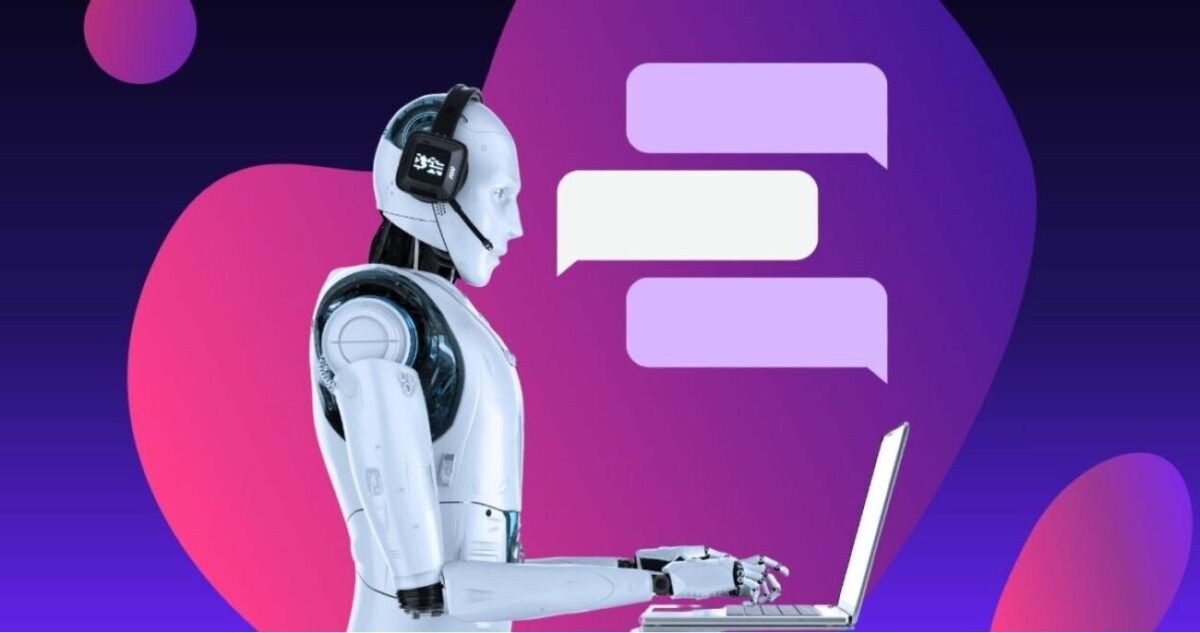
Here’s a scenario: you chat up your service or product provider, and a chatbot offers you a range of options. None of those options touches your concern, so you try to find a way to talk to a human. But soon enough, the chatbot leads you around in circles, and you find yourself frustrated and irritated – and your concern is left unaddressed.
Sounds familiar?
If you don’t want your patrons to suffer the same fate, here’s a possible solution: AI chatbots. In this article, we’ll discuss the benefits of AI chatbots and how they operate differently from regular chatbots.
We’ll also go over some of the most popular providers and offer tips on how to make the most out of this technology. Let’s begin!
Table of Contents
What is an AI chatbot?
- What is an AI chatbot?
- Key Benefits of AI Chatbots
- How Do AI Chatbots Work?
- Rule-Based Chatbots vs. AI Chatbots
- AI Chatbots Case Studies
- Chatbot Mistakes to Avoid
- Frequently Asked Questions
An AI chatbot is an app designed to simulate conversations with humans. It uses natural language processing (NLP) and machine learning (ML) to understand, interpret, and respond to queries in a human-like manner.
Compared to traditional rule-based chatbots that rely on predefined rules, AI chatbots can learn from interactions, adapt responses, and handle a wide range of conversational topics without being limited to specific keywords or scripts.
Because it’s not limited to a traditional chatbot’s parameters, it allows for more engaging and personalized user experiences.
Key Benefits of AI Chatbots
Here are the key advantages of AI chatbots and why many ventures are considering them as a welcome addition to their arsenal of AI in digital marketing tools.
Enhanced Customer Service Across Industries
AI chatbots have made significant inroads in various industries, each recognizing the unique advantages these digital assistants offer.
In fact, recent data from Invesp reveal a growing trend toward automation and personalized customer service.
Customers’ Acceptance of AI Chatbots by Industry (Data Source – Invesp)
The AI chatbots statistics above show that the tool also impacts sectors where trust and timely information are paramount, such as banking and financial advice.
Preference for Efficiency Over Human Interaction
Tidio‘s data shows that more than six out of 10 consumers would opt to engage with a chatbot rather than wait 15 minutes for a human agent.
Chatbots vs. Customer Service Agents (Data Source: Tidio)
This statistic underscores how customers value their time and seek instant solutions to their problems, making AI chatbots an attractive option for ventures working to cater to these expectations.
Transforming the Customer Experience
AI chatbots offer a host of benefits that extend beyond mere convenience. They are capable of:
- Providing answers to common questions around the clock
- Handling restaurant food orders
- Managing new client onboarding procedures
- Assisting customers with navigating online payment systems
- Identifying customer needs before directing them to the appropriate department
- Communicating with customers across a wide range of platforms (e.g. websites, WhatsApp, SMS)
- Instantly communicating in hundreds of different languages right from the start
The level of personalization and accessibility AI chatbots offer can significantly enhance customer experience, making it a good tool that complements a solid creative strategy.
How Do AI Chatbots Work?
Unlike traditional chatbots that operate based on rigid, pre-defined pathways set by humans, AI chatbots understand the structure of sentences and process this info to improve responses over time.
Here’s how it works:
- User’s Input. The user encodes their query on the AI chatbot.
- Request Analysis. The AI chatbot comprehends sentence structure through NLP. This process allows the chatbot to analyze the input’s grammar, context, and intent. Through this analysis, AI chatbots can identify the core of what is being asked rather than simply scanning for keywords or phrases.
- Identification of Intent and Entities. Once the AI chatbot understands the user’s question, it proceeds to deduce the intent behind it. This involves piecing together the user’s goal—is it to obtain information, resolve an issue, or perform a specific action?
- Response Composition. After clearly understanding the intent, the chatbot formulates a response based on the data it has access to. The response is not just a canned reply but one that is tailor-fit to address the user’s needs.
Image Licensed by Penji
A key characteristic of AI chatbots is their ability to learn from interactions. They continuously learn from their actions. By observing the outcomes of their responses—distinguishing between what is deemed correct and incorrect by users or supervisors—AI chatbots refine their understanding of what constitutes the ‘right’ answer.
Rule-Based Chatbots vs. AI Chatbots
Rule-based chatbots operate on a set of predefined rules and pathways to respond to user queries.
To illustrate how a rule-based chatbot works, I tried using Manychat, which is a chat bot online free of charge within a certain contact limit. The dashboard required me to create an automation flow with pre-determined messages, buttons, and answers:
Testing Manychat’s automation
In a way, this tool is very useful, especially for businesses who answer a lot of basic queries like product questions, links to shops, or shipping time inquiries.
To compare, I tried a popular AI chatbot online, LiveChat. To set up the chatbot, the system asked me for a website, and I used Penji’s website.
The next stage was “training” the chatbot. After the system analyzed the website, it came up with a set of cards with toggle buttons:
I didn’t disable anything at this point and proceeded to the “tuning chatbot” stage. The system took me to this template. Here, you can use the text automatically generated from your website or modify it to suit your brand style guide.
After the setup, training, and tuning stages, the system generated a flowchart:
LiveChat’s AI-generated flowchart
I tested the bot and asked it a few questions. Akin to AI email marketing tools, the AI chatbot generated texts based on the bits of information it already has.
As you could see from the third screenshot, you still need to train the bot to answer certain queries. However, it’s not as tedious as setting it up from scratch like you need to do when using rule-based chatbots.
With AI chatbots, it’s more of connecting a query with information that it already gleaned from a source material (in this case, a website) so you don’t have to spend a lot of time composing texts and designing flowcharts.
AI Chatbots Case Studies
Here are a few interesting case studies that provide a peek into how AI chatbots are used in the industry – and how they can go wrong or significantly enhance customer experiences.
Expedia’s Travel Planning Feature
Expedia has introduced a new in-app travel planning feature powered by ChatGPT, allowing members to engage in open-ended conversations for personalized recommendations on destinations, accommodations, transportation, and activities.
This innovative experience facilitates intelligent trip planning by saving hotel options to a “trip” within the app for easy date selection. In addition, it also integrates with Expedia’s other AI-driven features for a more intuitive trip building process.
In a way, this feature allows users to interact with Expedia in a personalized way, making every session more relevant and tailor-fit to one’s needs.
Air Canada’s AI Chatbot Mishap
Though AI chatbots offer a range of benefits, it could also lead to a miscommunication quagmire if not managed well.
In a landmark small claims court case in Canada in February 2024, Air Canada was held accountable for misleading information provided by its AI-powered chatbot to a grieving passenger regarding bereavement fares.
The airline company’s AI chatbot mistakenly informed a passenger Jake Moffatt that he could apply for a bereavement fare discount after booking a full-fare flight for his grandmother’s funeral, contrary to the airline’s policy that applications must be submitted beforehand.
When Moffatt sought the discount, the airline denied it, stating the chatbot was a “separate legal entity” and blaming Moffatt for not verifying the policy through a provided link. However, the British Columbia Civil Resolution Tribunal ruled against Air Canada, ordering it to compensate Moffatt $812.02, emphasizing that the airline is responsible for all information on its website, regardless of the source.
Here are a few lessons we can glean from Air Canada’s AI chatbot case:
- Ensure that AI chatbots are programmed with accurate, up-to-date information to avoid providing users with incorrect or misleading responses.
- Implement regular checks and updates to the AI system to maintain the relevance and accuracy of the information provided by chatbots.
- Understand that businesses can be held legally and financially accountable for the information provided by their AI chatbots.
- It goes without saying that AI can’t replace humans. Clearly communicate the limitations of AI chatbots to customers and provide direct access to human support for complex issues.
Frequently Asked Questions (FAQs)
What does an AI chatbot do
An AI chatbot is a software application that simulates human-like conversations with users through text or voice interactions. It understands and interprets user queries, generates relevant responses, and learns from interactions to improve over time. AI chatbots are designed to automate tasks, provide 24/7 assistance, and offer personalized user experiences across various platforms.
Which is the best AI chatbot?
Identifying the best AI chatbot for customer service depends on specific needs, including the level of conversational complexity required, integration capabilities with existing systems, and the languages supported. It’s best to check possible chatbot providers and test which ones fit your needs best before committing to a solution.
Is AI chatbot free?
Some AI chatbots offer free versions or trial periods, allowing users to explore basic features without upfront costs. However, advanced features, higher usage limits, and comprehensive support typically require paid subscriptions. The cost can vary widely based on the complexity of the chatbot, the level of customization, and the scale of deployment.
The Bottom Line
As we’ve explored the world of AI chatbots and their transformative potential for customer engagement and service, it’s clear that integrating AI chatbots into your strategy is something worth exploring, at the very least.
But just like any other AI-driven tech, like AI painting generators, AI chatbots are but tools. Just as human graphic designers offer deeper context into art, illustrations, and designs, in the end, it’s still up to us to incorporate human cognition and warmth into our conversations with our customers rather than leaving everything to automation.
About the author

Carla Deña
Carla is a journalist and content writer who produces stories for both digital and legacy media. She is passionate about creativity, innovation, and helping small businesses explore solutions that drive growth and social impact.










